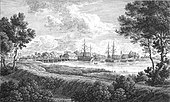Burger Heerstrasse
| Burger Heerstrasse | |
|---|---|
| Street in Bremen | |
| 1806: Gohgericht Werderland (detail), map by Christian Abraham Heineken ; Middle-right above: Castle with the way from Oslebshausen to Burg | |
| Basic data | |
| city | Bremen |
| district | Groepelingen |
| Created | 17th century |
| Cross streets | An Smidts Park, Am Burger Wall, Buschmannsweg, Burger Dorfstr., Alte Lesumbroker Landstr., Lesumbroker Landstr., Am Burgplatz, Grambkermoorer Landstr. |
| use | |
| User groups | Cars, bikes and pedestrians |
| Road design | two lane road |
| Technical specifications | |
| Street length | 600 meters |
The Burger highway is a key transit and access road in Bremen , district Burglesum , district Burg-Grambke . It leads in a south-north direction from Grambker Heerstraße through Burg to Lesum and Bremer Heerstraße to Bremerhaven.
The cross streets and connecting streets were named u. a. as Grambker Heerstraße after the district, An Smidts Park after the former park of the politician and theologian Mayor Johann Smidt (1773-1857), Am Burger Wall after the old castle, Buschmannsweg (unclear), Burger Dorfstraße, Alte Lesumbroker Landstraße and Lesumbroker Landstraße after the place in Werderland , Am Burgplatz, Grambkermoorer Landstraße after the place in the boggy area and Bremer Heerstraße ; otherwise see the link to the streets.
history
Surname
The Burger Heerstraße was named after the village and in 1916 after the street built in 1821/22. The castle was called Borch in 1277 and Borgh in 1371 . In Bremen and Umzu, many military roads were built after 1800 or roads were named as military roads (see Bremen streets ).
development
The old village of Burg on the Bremer Düne and the castle belonged to the Archbishopric of Bremen and in the 15th century to Goh Werderland . The castle from the middle of the 14th century was razed around 1784 . In the First Bremen-Swedish War in 1654, Swedish troops attacked the strategically important Lesum crossing and occupied the Burger Schanze . When the position was shot at, the Burger Church was also destroyed. Burg has belonged to the Grambke parish since 1654 . In 1803 Burg and Grambke became Bremen's land area, and the castle had around 135 inhabitants. In 1855 the castle had 288 inhabitants, in 1921 it was incorporated. In 1903 the pharmacist Wilhelm August Egeling (1861–1929) was granted a license and since 1904 has been running the Burg pharmacy .
traffic
The first Lesum bridge was built in 1350. The old road, which was found three meters deep during sewer work in 1950, probably came from this time.
In 1903 the street was opened up with the Bremen tram . The tram line 8 operated here until 1949. This was converted to trolleybuses in 1949 and to diesel buses in 1961.
Before the A 27 motorway was built, all long-distance traffic from Bremen to Bremerhaven ran through Burger Heerstraße . From 1932 it was part of the trunk road 6 (today Bundesstrasse 6 ). The roadway was widened in 1950 from 6.70 meters to 9 meters.
In local transport in Bremen, the bus routes 90 (Gröpelingen ↔ Neuenkirchen), 91/92 (Gröpelingen ↔ Rönnebeck), 93 (Gröpelingen ↔ Marßel), 95 (Gröpelingen ↔ Bockhorn) as well as 660 (Bremen Hbf - Hagen) and 680 (Gröpelingen - Wallhöfen) the street.
Buildings and facilities
On the street there are mostly one- to two-story houses.
- No. 20/22: Gut Hohekamp with 2-tier. plastered manor house with hipped roof and Hofmeierhaus from around 1825 and park from around 1840 as well as conversions from 1906 according to plans by Alfred Runge and Eduard Scotland and 1913 by Wilhelm Blanke ; Owner u. a. General director Heinrich Wiegand , broker Eduard Focke and general director Carl Erling . In the 16th century. Meierhof Hohekamp with a country house from 1509 with changing owners.
Notable buildings and facilities
- Green area with three-part Burger Lake
- No. 22b-c: 1-gesch. newer terraced houses
- No. 19: 2-sch. Burg-Apotheke, old building from 1904, complete renovation from 1972
- No. 26: 1-sch. House from around 1900/10 with a distinctive gable with neoclassical facade elements
- No. 38: 1-gesch. House from around 1900/10 with a distinctive gable
- No. 44: 2-sch. Residential and commercial building with 3-storey. Gable bay window with the self-service branch of Sparkasse Bremen
- No. 48: 2-sch. Newer residential and commercial building with Volksbank Bremen-Nord
- No. 50: 2-sch. Residential and commercial building with restaurant on the Lesum
- Lesum and Lesum Bridge from 2013
See also
literature
- Herbert Black Forest : The Great Bremen Lexicon. 2nd, expanded and updated edition. In two volumes. Edition Temmen , Bremen 2003, ISBN 3-86108-693-X (first edition: 2002, supplementary volume A – Z). 2008, ISBN 978-3-86108-986-5 .
- Monika Porsch: Bremer Straßenlexikon , complete edition. Schünemann, Bremen 2003, ISBN 3-7961-1850-X .
Individual evidence
- ↑ a b Heerstraße from the 14th century, Weser-Kurier from September 23, 1950, p. 4, online only for subscribers
- ↑ Monument database of the LfD Bremen
Coordinates: 53 ° 9 ′ 14.7 " N , 8 ° 42 ′ 17.5" E



